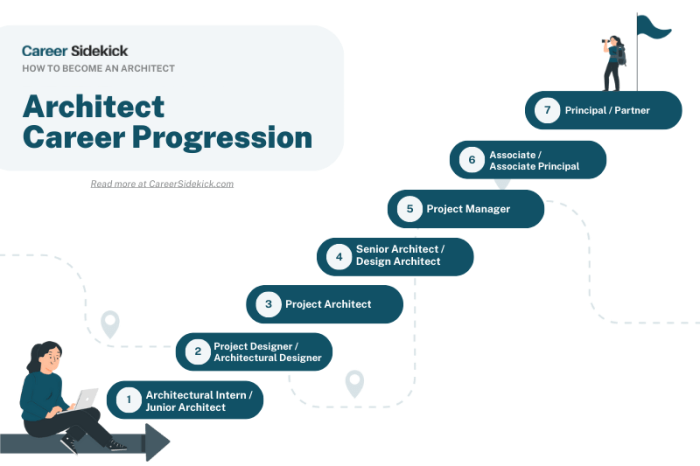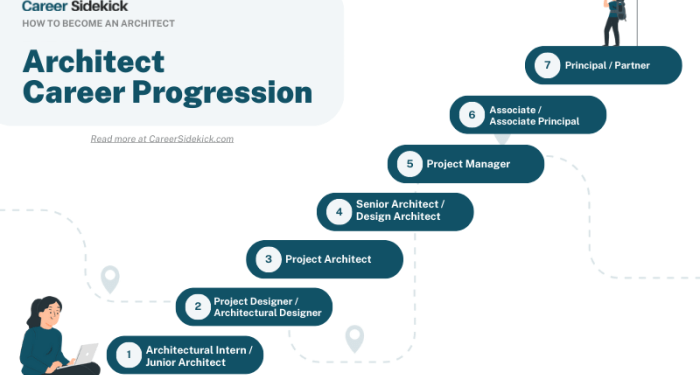Embark on a journey into the world of architecture with our guide on how to kickstart your career in this dynamic field. From researching the industry to building a standout portfolio, we cover all the essentials for aspiring architects.
Researching the Field

Before embarking on a career in architecture, it is crucial to conduct thorough research to gain a comprehensive understanding of the field and its various aspects. Researching allows individuals to make informed decisions, set realistic goals, and navigate the complexities of the architectural profession effectively.
Key Areas for Research
- Architectural Styles and Movements: Familiarize yourself with different architectural styles and movements throughout history, such as Modernism, Postmodernism, and Brutalism. Understanding these styles will provide insights into design principles and philosophies that have shaped the built environment.
- Building Materials and Construction Techniques: Explore the various building materials and construction techniques used in architecture, including sustainable practices and innovative technologies. This knowledge will be essential in creating environmentally conscious and structurally sound designs.
- Architectural Firms and Projects: Research prominent architectural firms, their portfolios, and notable projects to gain an understanding of the industry landscape. Studying successful projects can offer inspiration and insights into design processes and project management.
Benefits of Understanding Architectural History
Understanding the history of architecture is fundamental to career development as it provides a contextual foundation for design decisions and creative exploration. By studying architectural history, individuals can:
- Gain Inspiration: Learning about iconic buildings and architects from the past can spark creativity and provide innovative ideas for contemporary design projects.
- Learn from Past Mistakes: Analyzing historical architectural failures and successes can help architects avoid repeating mistakes and improve future design outcomes.
- Appreciate Cultural Context: Architectural history offers insights into how culture, society, and technology have influenced design trends over time, fostering a deeper appreciation for the built environment.
Education and Training
Embarking on a career in architecture requires a solid foundation of education and training to succeed in this competitive field.
Typical Education Path
Individuals aspiring to become architects typically follow a structured education path that includes obtaining a professional degree in architecture, gaining practical experience through internships, and eventually becoming licensed. The typical steps include:
- Completing a Bachelor's degree in Architecture: This undergraduate program provides a fundamental understanding of architectural principles, design concepts, and technical skills.
- Pursuing a Master's degree in Architecture: Many individuals choose to further their education with a Master's degree to deepen their knowledge and specialization in specific areas of architecture.
- Completing an Internship: Practical experience through internships with architectural firms is crucial to gaining real-world exposure and honing skills in a professional setting.
- Obtaining Licensure: Architects must pass the Architect Registration Examination (ARE) and fulfill the requirements set by the state licensing board to become a licensed architect.
Types of Degrees in Architecture
There are different types of degrees in architecture, each offering unique advantages based on career goals and aspirations:
| Degree Type | Advantages |
|---|---|
| Bachelor of Architecture (B.Arch) | Direct path to licensure, emphasis on design studio work, shorter duration compared to B.Arch + M.Arch path. |
| Bachelor of Science in Architecture (B.S. Arch) | Focus on technical aspects of architecture, flexibility to pursue other career paths. |
| Master of Architecture (M.Arch) | Specialization in specific areas of architecture, preparation for advanced roles in the field. |
Importance of Internships and Practical Experience
Internships and practical experience play a vital role in an architect's education and training:
- Hands-on Experience: Internships provide the opportunity to apply theoretical knowledge in practical settings, gaining valuable hands-on experience.
- Professional Networking: Building relationships with industry professionals during internships can lead to future job opportunities and mentorship.
- Skill Development: Practical experience helps architects develop essential skills such as project management, client communication, and teamwork.
- Industry Insights: Internships offer a glimpse into the daily operations of architectural firms, providing valuable insights into the industry.
Building a Portfolio
Building a strong portfolio is crucial in the architecture industry as it serves as a visual representation of your skills, creativity, and style to potential employers or clients. A well-curated portfolio can set you apart from other candidates and showcase your ability to bring ideas to life.
Designing a Diverse and Impressive Portfolio
Creating a diverse and impressive portfolio involves showcasing a range of skills, projects, and experiences. Here's a strategy to help you build a standout portfolio:
- Include a variety of projects: Display a mix of academic work, personal projects, internships, and professional work to demonstrate your versatility and expertise.
- Showcase different design styles: Include projects that highlight your ability to work in various architectural styles, from modern and contemporary to traditional and sustainable.
- Highlight your process: Provide insight into your design process by including sketches, renderings, models, and final presentations to showcase how you approach and develop a project from concept to completion.
- Organize effectively: Arrange your portfolio in a clear and visually appealing manner, with a concise description of each project, highlighting your role, design challenges, and solutions.
Showcasing Academic Work and Real-World Projects
When including academic work and real-world projects in your portfolio, consider the following tips:
- Academic work: Select projects that demonstrate your design skills, creativity, and theoretical knowledge. Include drawings, renderings, models, and written descriptions to showcase your understanding of architectural principles and concepts.
- Real-world projects: Highlight your professional experience by including projects you've worked on during internships, collaborations, or freelance work. Focus on projects that best represent your design abilities, problem-solving skills, and attention to detail.
- Balance is key: Strike a balance between academic and real-world projects to show a comprehensive view of your capabilities. Tailor your portfolio to the specific job or opportunity you're applying for, emphasizing relevant experience and skills.
Networking and Mentorship
Networking and mentorship play crucial roles in kickstarting and advancing a career in architecture. By connecting with professionals in the field and seeking guidance from experienced mentors, aspiring architects can gain valuable insights, opportunities, and support to navigate their career paths effectively.
Networking Opportunities for Aspiring Architects
Networking opportunities for aspiring architects are abundant and can be found both online and offline. Some potential networking avenues include:
- Attending industry events, conferences, and workshops to meet and connect with professionals in the field.
- Joining architecture-related organizations, associations, or networking groups to expand your professional circle.
- Utilizing social media platforms like LinkedIn to connect with industry professionals, share your work, and stay updated on industry trends.
- Participating in design competitions or collaborative projects to showcase your skills and build relationships with peers and potential mentors.
The Impact of Mentorship in Architecture
Mentorship can have a profound impact on career growth and development in the field of architecture. A mentor can offer valuable guidance, support, and advice based on their own experiences and expertise, helping mentees navigate challenges, make informed decisions, and achieve their professional goals.
By forming mentor-mentee relationships, aspiring architects can benefit from personalized learning, networking opportunities, and career advancement in the industry.
Developing Technical Skills
Developing technical skills is crucial for a successful career in architecture. These skills encompass a range of abilities that are essential for designing, planning, and constructing buildings. Here are some key technical skills required for aspiring architects:
Essential Technical Skills
- Proficiency in architectural drafting and design software such as AutoCAD, Revit, and SketchUp
- Knowledge of building information modeling (BIM) tools for creating 3D models and simulations
- Understanding of construction methods, materials, and structural systems
- Ability to read and interpret architectural drawings and blueprints
- Skills in sustainable design and green building practices
Improving Technical Skills
- Take online courses or workshops to enhance software proficiency
- Participate in architectural design competitions to practice applying technical skills
- Seek mentorship from experienced architects to gain hands-on experience
- Attend industry conferences and seminars to stay updated on the latest trends and technologies
Importance of Staying Updated
Staying updated with the latest technological advancements in architecture is crucial for remaining competitive in the field. Advancements such as virtual reality, parametric design, and sustainable technologies are transforming the way architects work. By staying informed and continuously improving technical skills, architects can deliver innovative solutions and stay ahead of industry trends.
Ending Remarks
As we conclude our discussion on starting a career in architecture, remember that dedication and passion are key ingredients for success in this competitive field. With the right education, skills, and networking, you can pave the way for a fulfilling architectural career ahead.
FAQ
Why is research crucial before starting a career in architecture?
Research helps you understand industry trends, design principles, and potential job opportunities, giving you a competitive edge in the field.
What are the key areas within architecture to focus research on?
Focus on architectural styles, famous architects, sustainable design practices, and emerging technologies shaping the industry.
How can mentorship impact career growth in architecture?
Mentorship offers valuable guidance, industry insights, and networking opportunities that can accelerate your career progression in architecture.
What are the essential technical skills required for a successful career in architecture?
Technical skills like AutoCAD proficiency, 3D modeling, building information modeling (BIM), and knowledge of construction materials are crucial for architects.



